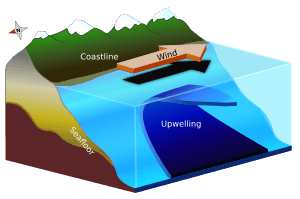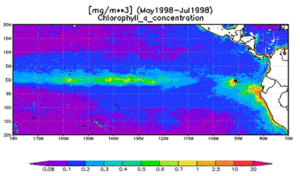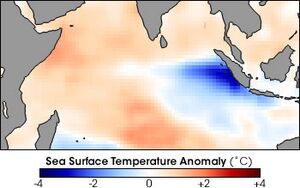Upwelling facts for kids
Upwelling is like a giant elevator in the ocean. It's a process where wind pushes water on the surface, allowing deep, cold water to rise up. This deep water is usually full of nutrients, which are like food for tiny ocean plants.
When this nutrient-rich water reaches the surface, it helps tiny plants called phytoplankton to grow. Because of all this new plant life, upwelling zones are full of fish and other sea creatures. These areas can be spotted from space because the water is cooler and full of life.
Even though upwelling zones only make up a small part of the ocean, they are very important. About 25% of all fish caught in the world come from just five major upwelling areas.
Contents
What Causes Upwelling?
Three main things work together to create upwelling: the wind, the Coriolis effect (caused by the Earth's spinning), and Ekman transport (how water moves because of wind).
Here's how it works:
- Wind blows across the ocean's surface.
- Because the Earth is spinning, the water doesn't move in the exact same direction as the wind. This is the Coriolis effect. In the Northern Hemisphere, water moves to the right of the wind. In the Southern Hemisphere, it moves to the left.
- The top layer of water starts moving and drags the layer below it, which drags the layer below that. This creates a spiral of moving water. The overall result is that a large amount of surface water moves away. This is called Ekman transport.
- When all that surface water moves away from an area, deep water from below must rise up to fill the space. This is upwelling!
Where Does Upwelling Happen?
Upwelling happens in several different parts of the world's oceans. There are a few main types.
Along the Coastlines
Coastal upwelling is the most famous type. It creates some of the world's best fishing spots. This happens when wind blows parallel to a coastline. The wind and the Coriolis effect push the surface water away from the coast.
To replace the surface water, cold, dense water from the deep ocean rises up. This deep water is full of nutrients like nitrate and phosphate. These nutrients come from dead plants and animals that have sunk and decomposed.
These nutrients act like a fertilizer for phytoplankton. With sunlight and nutrients, phytoplankton grow quickly through photosynthesis. This creates a huge amount of food and starts a rich food chain:
- Phytoplankton (tiny plants) are eaten by...
- Zooplankton (tiny animals), which are eaten by...
- Small fish and filter feeders, which are eaten by...
- Bigger fish, sea birds, and marine mammals.
There are five major coastal areas where upwelling happens:
- The Canary Current (off Northwest Africa)
- The Benguela Current (off southern Africa)
- The California Current (off California and Oregon)
- The Humboldt Current (off Peru and Chile)
- The Somali Current (off Somalia and Oman)
At the Equator
Upwelling also happens along the equator. Here, trade winds blow from the east, pushing surface water both north and south, away from the equator.
This creates a gap, and cold, nutrient-rich water from the deep ocean rises to fill it. This is why the middle of the Pacific Ocean has a wide line of phytoplankton that is so big it can be seen from space.
Around Antarctica
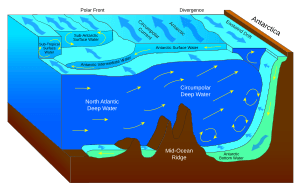
The Southern Ocean around Antarctica has very strong winds that blow to the east. These winds push a lot of surface water north, away from the continent.
This is a very large-scale type of upwelling, where water from very deep in the ocean is pulled up to the surface. In some areas, this upwelling brings warmer deep water near the coast, which can cause ice on the continent to melt faster.
Other Kinds of Upwelling
- Upwelling can happen near underwater mountains (called seamounts) or islands. When deep ocean currents hit these obstacles, the water is forced upward, creating a nutrient-rich spot.
- A tropical cyclone (like a hurricane) can also cause upwelling. As the storm moves slowly over the ocean, its powerful winds push surface water away from the center, pulling deep water up.
Is Upwelling Always the Same?
The strength of upwelling can change. It depends on the wind, the time of year, and the shape of the ocean floor.
In some places, upwelling is seasonal. For example, off the coast of Oregon in the United States, upwelling is strong in the spring and summer but weak or absent in the winter. This is because the temperature difference between the land and the sea changes with the seasons.
In tropical areas, upwelling can happen all year long. The upwelling off the coast of Peru is a good example. It supports one of the world's largest fisheries for sardines and anchovies.
Sometimes, the normal wind patterns change. During an El Niño event, the trade winds weaken. This stops or reduces upwelling. The water becomes warmer and has fewer nutrients. This can cause a big drop in the number of fish and other animals, hurting the fishing industry.
An Ocean Full of Life
Upwelling regions are some of the most fertile places on Earth. They are packed with hundreds of different species.
Scientists have noticed a special pattern in these ecosystems. At the bottom of the food chain, there are hundreds of types of tiny plants and animals. At the top, there are many kinds of predators like large fish, sea birds, and marine mammals.
But in the middle, there are usually only one or two species of small, open-ocean fish, like sardines or anchovies. These fish are the key to the whole system. They eat the tiny phytoplankton and are then eaten by almost every predator. They connect the bottom of the food chain to the top.
Dangers to Upwelling Areas
These rich ecosystems face some serious threats.
Overfishing
Because upwelling areas have so many fish, they are very popular for commercial fishing. This provides food and jobs for many people.
However, if too many fish are caught (a problem called over-fishing), it can damage the ecosystem. The small fish in the middle of the food chain, like sardines, are often the main targets. If their numbers drop too low, the predators that rely on them for food, like sea lions and birds, can starve. This can cause the entire food web to collapse.
El Niño Events
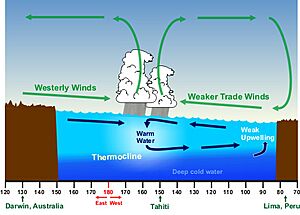
As mentioned before, El Niño is a major threat. When the winds weaken and upwelling stops, the supply of nutrients is cut off. Without their food source, the phytoplankton die off.
This causes a chain reaction up the food chain. The entire ecosystem, which depends on the constant supply of nutrients from the deep ocean, can struggle to survive.
How Upwelling Affects Weather
Coastal upwelling also has a big effect on the local weather. The cold water that rises to the surface cools the air directly above it.
This cool, moist air often forms sea fog and low stratus clouds. This can block the sun and prevent rain from forming over the ocean, which often leaves the nearby land very dry.
Cities in upwelling zones often have cool, dry climates. Some examples include San Francisco in the USA, Antofagasta in Chile, and Walvis Bay in Namibia. These places often have cool summers with fog, but not much rain.



